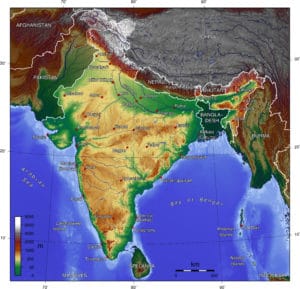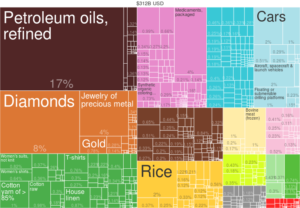India’s coastline measures 7,517 kilometres (4,700 mi) in length; of this distance, 5,423 kilometres (3,400 mi) belong to peninsular India and 2,094 kilometres (1,300 mi) to the Andaman, Nicobar, and Lakshadweep island chains. According to the Indian naval hydrographic charts, the mainland coastline consists of the following: 43% sandy beaches; 11% rocky shores, including cliffs; and 46% mudflats or marshy shores.

Major Himalayan-origin rivers that substantially flow through India include the Ganges and the Brahmaputra, both of which drain into the Bay of Bengal. Important tributaries of the Ganges include the Yamuna and the Kosi; the latter’s extremely low gradient, caused by long-term silt deposition, leads to severe floods and course changes. Major peninsular rivers, whose steeper gradients prevent their waters from flooding, include the Godavari, the Mahanadi, the Kaveri, and the Krishna, which also drain into the Bay of Bengal; and the Narmada and the Tapti, which drain into the Arabian Sea. Coastal features include the marshy Rann of Kutch of western India and the alluvial Sundarbans delta of eastern India; the latter is shared with Bangladesh. India has two archipelagos: the Lakshadweep, coral atolls off India’s south-western coast; and the Andaman and Nicobar Islands, a volcanic chain in the Andaman Sea.
The Indian climate is strongly influenced by the Himalayas and the Thar Desert, both of which drive the economically and culturally pivotal summer and winter monsoons. The Himalayas prevent cold Central Asian katabatic winds from blowing in, keeping the bulk of the Indian subcontinent warmer than most locations at similar latitudes. The Thar Desert plays a crucial role in attracting the moisture-laden south-west summer monsoon winds that, between June and October, provide the majority of India’s rainfall. Four major climatic groupings predominate in India: tropical wet, tropical dry, subtropical humid, and montane.
Economy:
According to the International Monetary Fund (IMF), the Indian economy in 2019 was nominally worth $2.9 trillion; it is the fifth-largest economy by market exchange rates, and is around $11 trillion, the third-largest by purchasing power parity, or PPP. With its average annual GDP growth rate of 5.8% over the past two decades, and reaching 6.1% during 2011–2012, India is one of the world’s fastest-growing economies. However, the country ranks 139th in the world in nominal GDP per capita and 118th in GDP per capita at PPP. Until 1991, all Indian governments followed protectionist policies that were influenced by socialist economics. Widespread state intervention and regulation largely walled the economy off from the outside world. An acute balance of payments crisis in 1991 forced the nation to liberalise its economy; since then it has moved slowly towards a free-market system by emphasising both foreign trade and direct investment inflows. India has been a member of WTO since 1 January 1995.

The 513.7-million-worker Indian labour force is the world’s second-largest, as of 2016. The service sector makes up 55.6% of GDP, the industrial sector 26.3% and the agricultural sector 18.1%. India’s foreign exchange remittances of US$70 billion in 2014, the largest in the world, were contributed to its economy by 25 million Indians working in foreign countries. Major agricultural products include: rice, wheat, oilseed, cotton, jute, tea, sugarcane, and potatoes. Major industries include: textiles, telecommunications, chemicals, pharmaceuticals, biotechnology, food processing, steel, transport equipment, cement, mining, petroleum, machinery, and software. In 2011, India was the world’s tenth-largest importer and the nineteenth-largest exporter. Major exports include: petroleum products, textile goods, jewellery, software, engineering goods, chemicals, and manufactured leather goods. Major imports include: crude oil, machinery, gems, fertiliser, and chemicals. Between 2001 and 2011, the contribution of petrochemical and engineering goods to total exports grew from 14% to 42%. India was the world’s second largest textile exporter after China in the 2013 calendar year.
Transportation:
Transport in India consists of transport by land, water and air. Public transport is the primary mode of road transport for most of the Indian citizens, and India’s public transport systems are among the most heavily used in the world. In total, about 21 percent of households have two wheelers whereas 4.7 percent of households in India have cars or vans as per the 2011 Census. The automobile industry in India is currently rapidly growing with an annual production of over 4.6 million vehicles, with an annual growth rate of 10.5% and vehicle volume is expected to rise greatly in the future.
